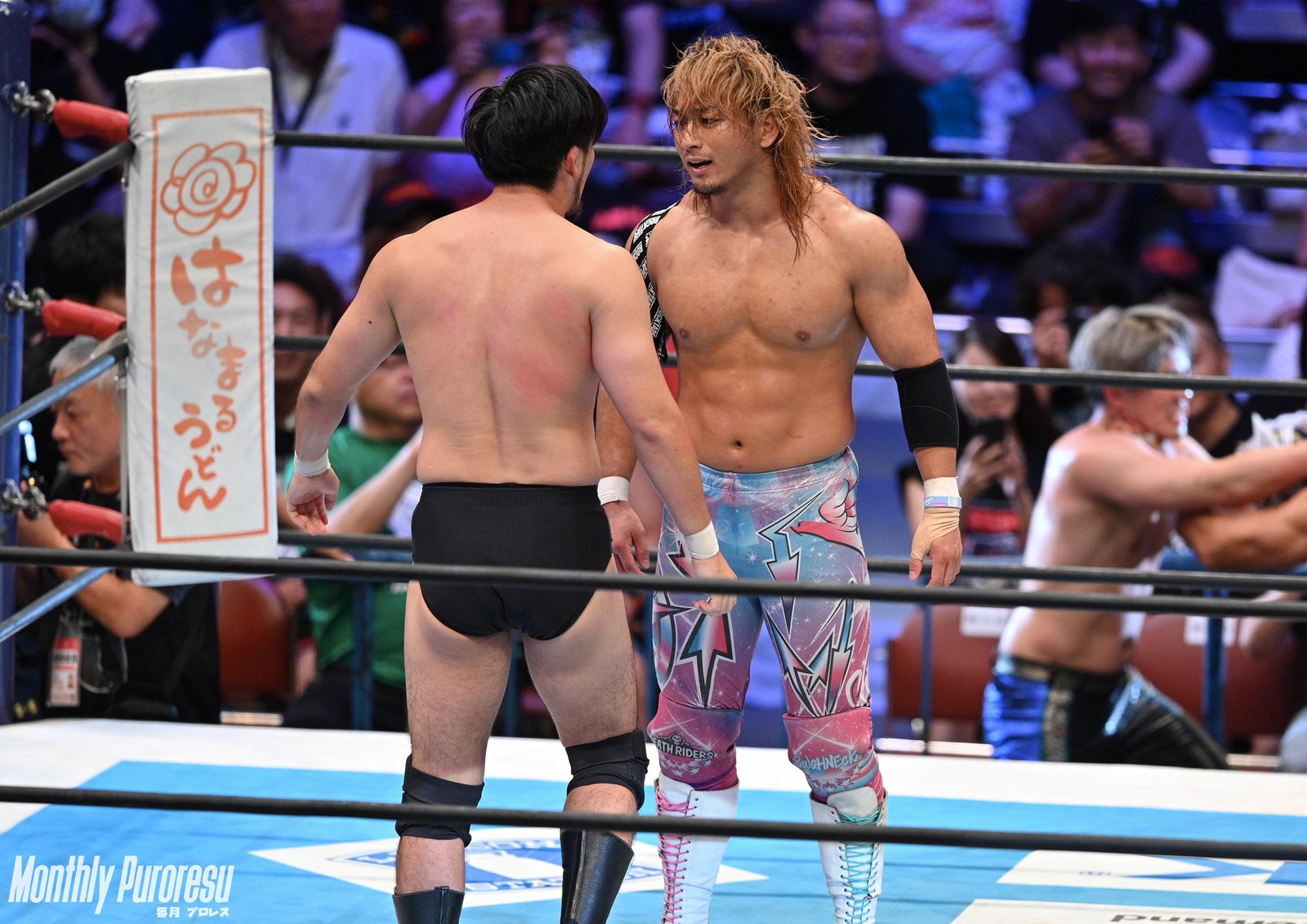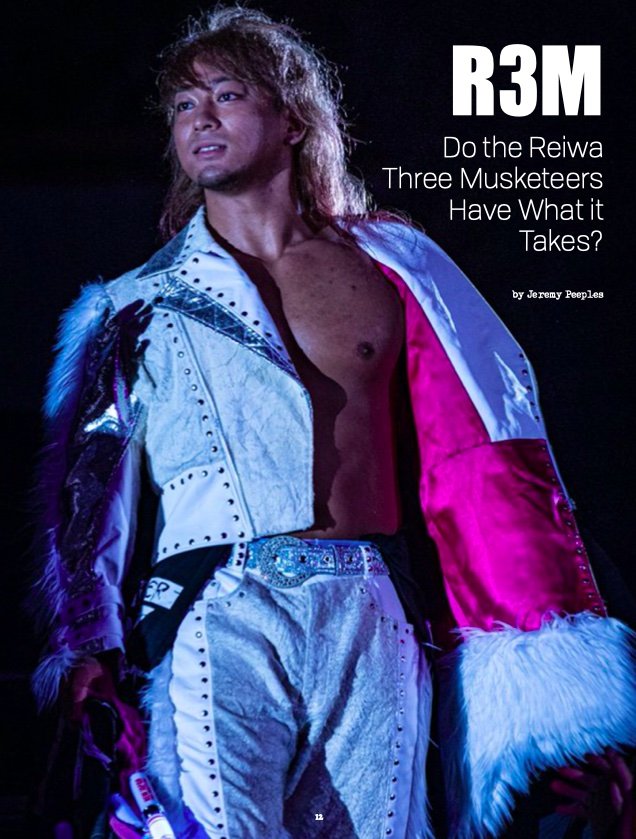The Uphill Battle for the Reiwa Three Musketeers

The Uphill Battle for the Reiwa Three Musketeers
By: Jeremy Peeples
New Japan recently announced a third set of Three Musketeers in the form of the Reiwa Musketeers – made up of Ren Narita, Shota Umino, and Yota Tsuji. Over the company’s 51 year history, we have seen the “Three Musketeers” tasked with carrying the company in its founder Antonio Inoki’s absence. The first two rounds featured a set of legends in Keiji Mutoh, Masahiro Chono, and Shinya Hashimoto and the second set of Shinsuke Nakamura, Hiroshi Tanahashi and Katsuyori Shibata blazed their own trails and in the case of Tanahashi, saved the company. The newest generation of musketeers has a lot to live up to – and their own unique handicaps to overcome, especially with the titles being bestowed upon them right before the G1.
Ren Narita has the toughest road to hoe because of how interlocked literally everything about his presentation has been with Shibata – down to his face, gear, and ring style. The musketeer label was something that Shibata himself had to leave New Japan to escape and then become the legend that he became within the company and that was with him being given the chance to blaze his own trail and doing so. Narita being presented as Shibata Lite worked as a young lion and even in the Shibata match at Wrestle Kingdom but will hurt him in the long haul.
The emphasis on him doing what Shibata can do and not on the skills he brings to the table that Shibata hasn’t had hurts him. He is far more flexible than Shibata and while Shibata has more intensity to what he does in the ring, Narita has a greater variety of tools in the tool box to work with. His bridging suplexes are Hiroshi Hase-like in their beauty and no one has had as impressive a bridge as Narita overall. The bout with Umino felt like a bridge between generations because you have Narita representing the Inoki-era look and more traditional pro wrestling style while Umino goes for more modern showmanship and keeps his offense crisp.
Both men are hurt by feeling like pastiches of others – with Umino being a blend of Moxley and a lot of Tanahashi’s look, but bringing his own flourishes to the ring style and that shined through even early on in the match. He gets Narita in the corner and hits a mix of European uppercuts and forearm shots and the tighter camera angle shows his gear, but still keeps the focus on him and in that fleeting moment, you get a glimpse of Umino finding his own voice in the ring before Narita fired back with a Shibata-esque corner high kick and uppercut.
Narita has a chance to shine in the G1 and beyond, but desperately needs to be given a chance to find his own stamp to put on the canvas instead of being limited to painting with Shibata’s brushes. He was given a chance to do a bit of that with Umino thanks to a lot of leg work on the mat. Over time, doing things like different leg submissions and making the torture cloverleaf into a finisher can help since Shibata is more of a striker than a submission artist and that’s a step in the right direction. Umino has added more tools from other arsenals like Claudio’s very European uppercut – but befitting the tale of each man needing to find their own path, going with everyone else’s tool kit resulted in a draw and neither man making forward progress in that match statistically.
However, as a career proving ground, it was a fascinating match to see unfold. The same held true for Narita vs. Yota Tsuji, which went to another time limit draw and reinforced how draws can happen while still telling a small story about this generation struggling to get the job done when it counts. That’s been a sub-story for all three as well, with only Narita holding the NEVER Six-Man Tag Team Titles, while Umino has fallen short on title bouts so far – with the Will Ospreay match at Historic X-Over on November 20, 2022 being a fine showcase for him even in defeat and falling to Zack Sabre Jr. at Sakura Genesis on April 8, 2023. The past year has been an interesting one to follow for Umino because his big wins have been few and far between, but he still feels like he’s a win away from a shot at any title in New Japan.
Umino in his current form feels a lot like Naito did pre-LIJ where they went with this squeaky-clean faux-angel getup for him and it just didn’t click. They wanted him to be a main event player, but that coat of paint wasn’t the way to accomplish that goal and Umino as a partial Tanahashi cosplayer with some of Moxley’s moves and small flourishes of his own. He’s used his speed to bust out incredible basement uppercuts and dropkicks with an early Muta-like snap to them. Umino definitely feels like the most ready-made main event act on paper, but there is something missing with him due to his presentation being too similar to others.
Nakamura was a rare example of a musketeer who took a long time to really find his footing no matter what push he was given as his excursion to Mexico led to him discovering his King of Strong Style character and fluid-like movements and counters during his peak years. That led to him being the title-defining IC Champion for years and the benchmark the title was held against while building his name up to legendary status that he’s lived off of in WWE for much of the past decade. Yota Tsuji reminds me a lot of Nakamura post-excursion because they both did extensive CMLL work and found a fountain of charisma during that journey.
Tsuji has shined so brightly returning and taking out SANADA before losing a near-match of the year contender at Dominion and then doing so again on day five of the G1. The G1 has a chance to be a big event for him because with that second loss to SANADA, they’re telling a story that the champion has his number and that’s good for SANADA and Tsuji. Everyone has a career rival in New Japan to some extent with Tanahashi having Okada and Nakamura, Okada having Tana and Omega, and Tsuji setting up something with SANADA that should pay off with either a long play of Tsuji beating him for the title or perhaps beating him in the New Japan Cup next year for another meaningful win for him.
The Reiwa Three Musketeers all have the tools to be major stars – with Ren Narita seemingly having the toughest mountain to climb. Shota Umino feels like the one who will get the biggest on-paper push because they’re clearly framing him as the Tanahashi for this generation, while Yota Tsuji evokes a lot of Nakamura only with more explosive athleticism. Like Nakamura, he wears bold leather gear and has a very expressive face and even coming back mere months ago, has found ways to make things like a violent curb stomp and dives into something that stand out because of how he does them. The future of New Japan is bright and the Reiwa Three Musketeers should usher in a new generation of fans coming to events for different reasons because each of them has their own dynasty to leave behind.
This article first appeared in Issue #12 of Monthly Puroresu.




